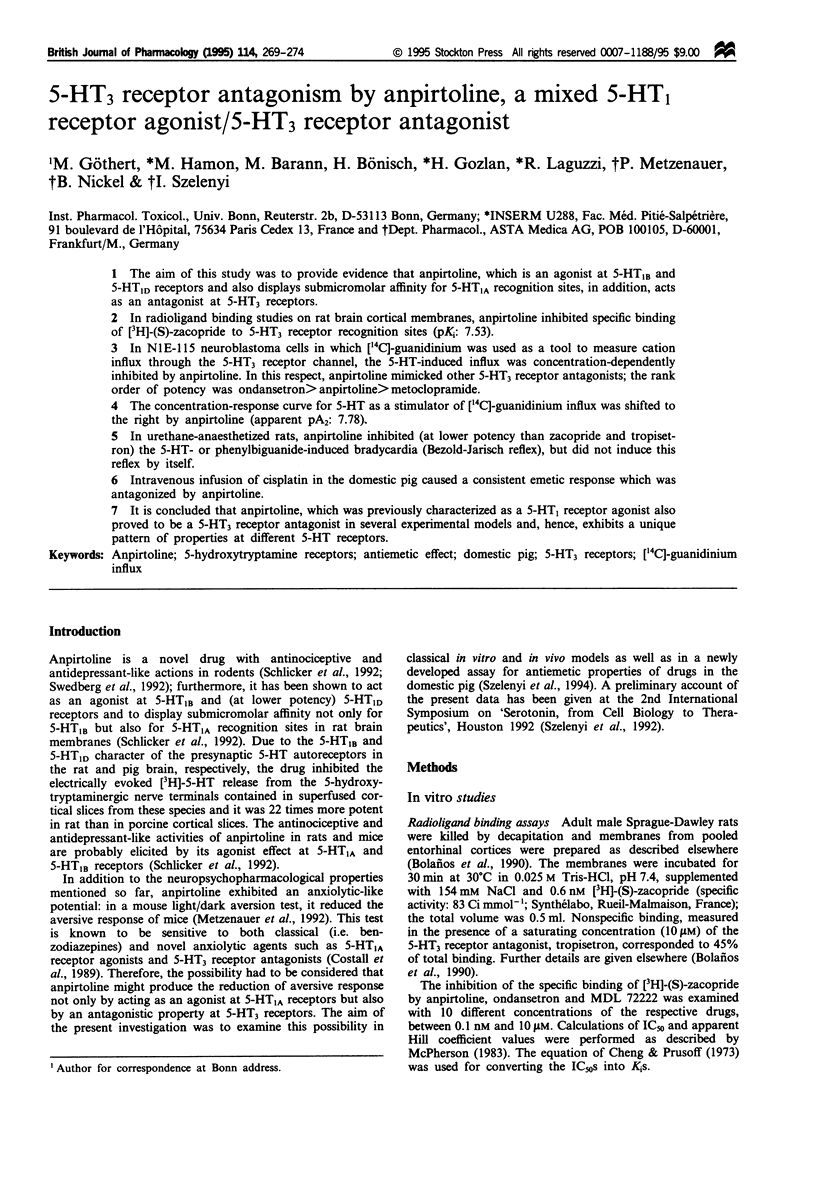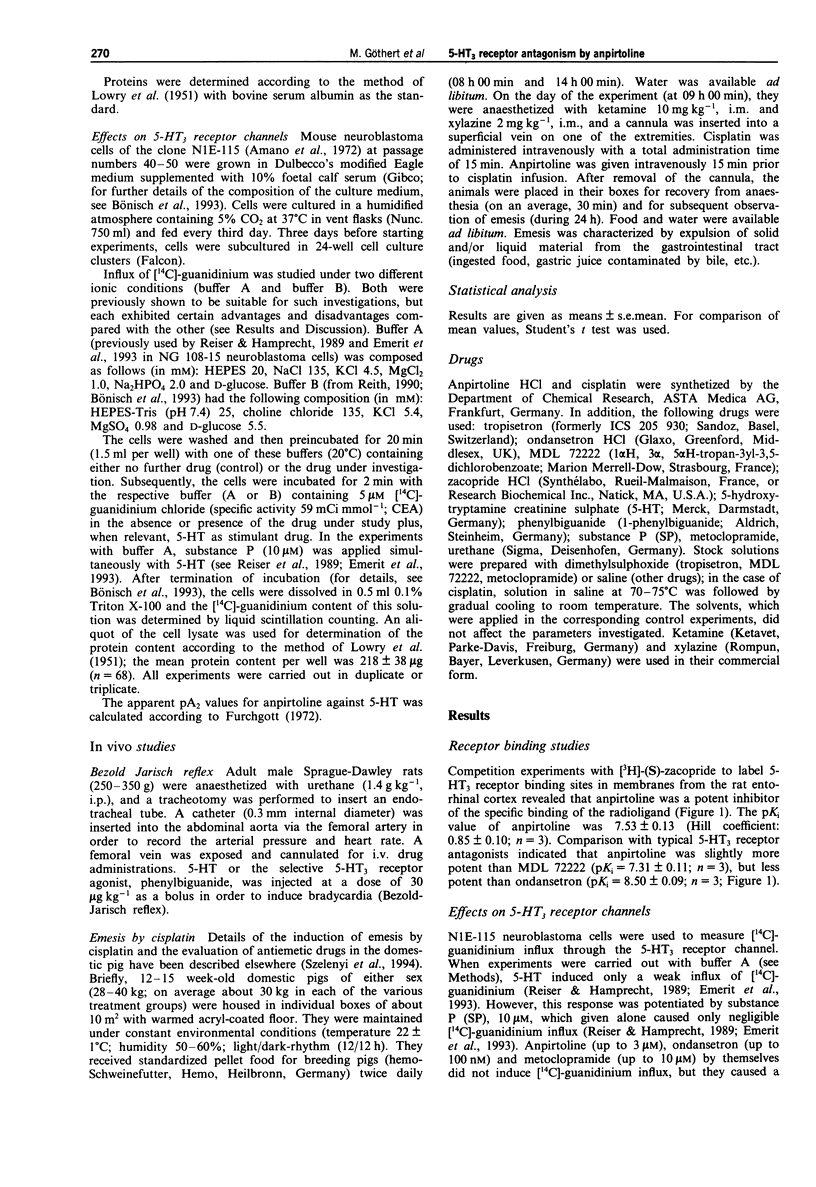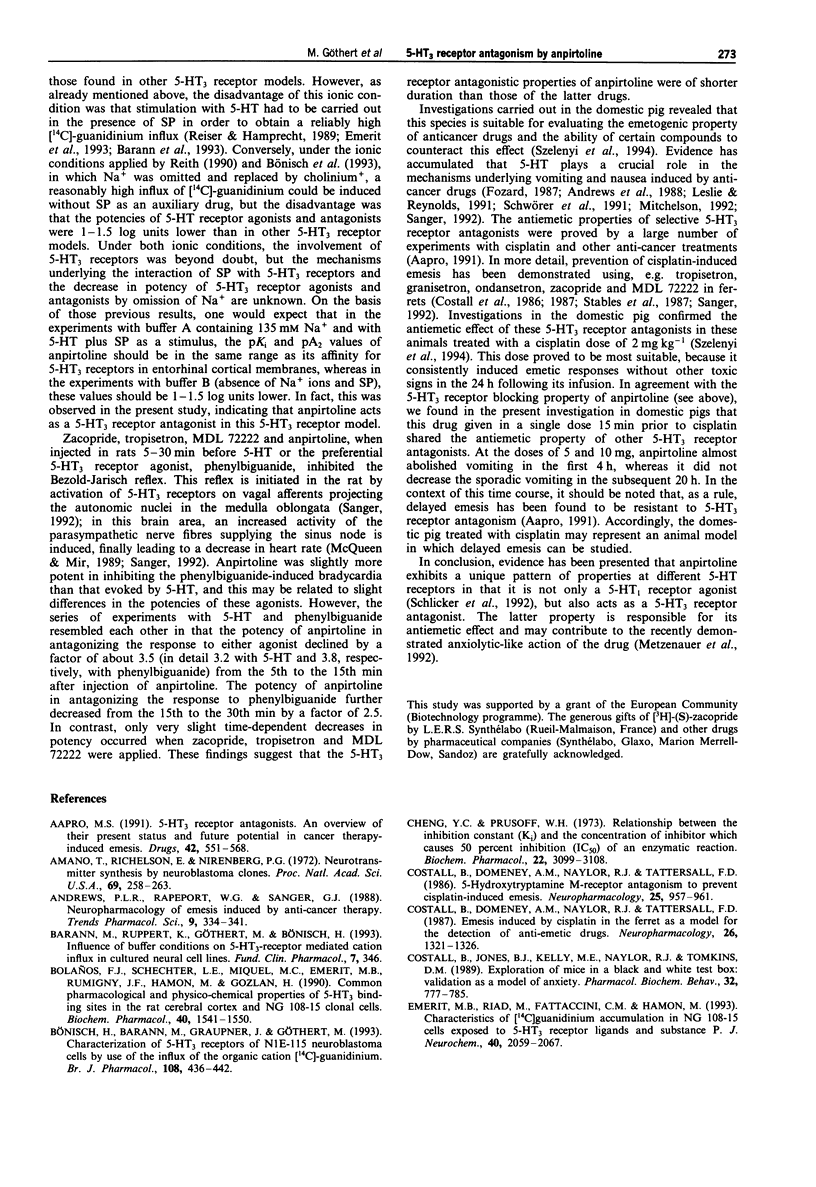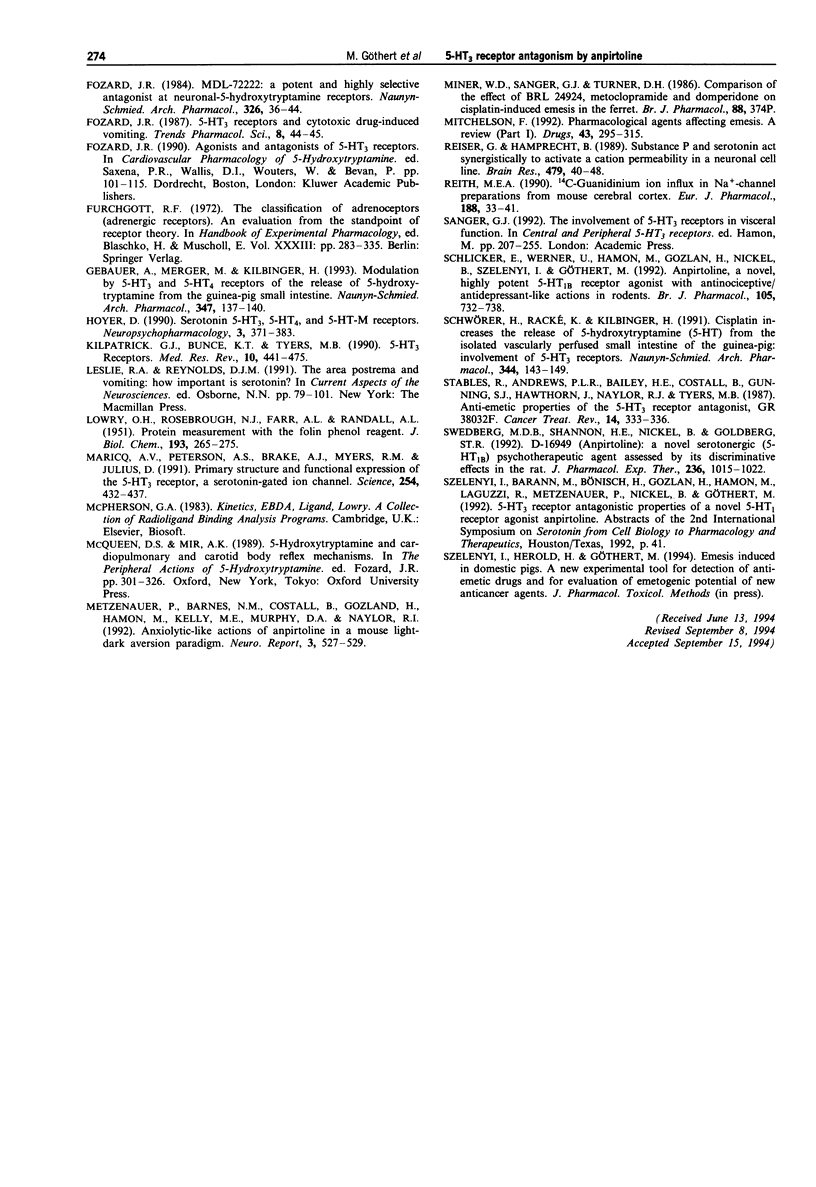Abstract
1. The aim of this study was to provide evidence that anpirtoline, which is an agonist at 5-HT1B and 5-HT1D receptors and also displays submicromolar affinity for 5-HT1A recognition sites, in addition, acts as an antagonist at 5-HT3 receptors. 2. In radioligand binding studies on rat brain cortical membranes, anpirtoline inhibited specific binding of [3H]-(S)-zacopride to 5-HT3 receptor recognition sites (pKi: 7.53). 3. In N1E-115 neuroblastoma cells in which [14C]-guanidinium was used as a tool to measure cation influx through the 5-HT3 receptor channel, the 5-HT-induced influx was concentration-dependently inhibited by anpirtoline. In this respect, anpirtoline mimicked other 5-HT3 receptor antagonists; the rank order of potency was ondansetron > anpirtoline > metoclopramide. 4. The concentration-response curve for 5-HT as a stimulator of [14C]-guanidinium influx was shifted to the right by anpirtoline (apparent pA2: 7.78). 5. In urethane-anaesthetized rats, anpirtoline inhibited (at lower potency than zacopride and tropisetron) the 5-HT- or phenylbiguanide-induced bradycardia (Bezold-Jarisch reflex), but did not induce this reflex by itself. 6. Intravenous infusion of cisplatin in the domestic pig caused a consistent emetic response which was antagonized by anpirtoline. 7. It is concluded that anpirtoline, which was previously characterized as a 5-HT1 receptor agonist also proved to be a 5-HT3 receptor antagonist in several experimental models and, hence, exhibits a unique pattern of properties at different 5-HT receptors.
Full text
PDF





Selected References
These references are in PubMed. This may not be the complete list of references from this article.
- Aapro M. S. 5-HT3 receptor antagonists. An overview of their present status and future potential in cancer therapy-induced emesis. Drugs. 1991 Oct;42(4):551–568. doi: 10.2165/00003495-199142040-00002. [DOI] [PubMed] [Google Scholar]
- Amano T., Richelson E., Nirenberg M. Neurotransmitter synthesis by neuroblastoma clones (neuroblast differentiation-cell culture-choline acetyltransferase-acetylcholinesterase-tyrosine hydroxylase-axons-dendrites). Proc Natl Acad Sci U S A. 1972 Jan;69(1):258–263. doi: 10.1073/pnas.69.1.258. [DOI] [PMC free article] [PubMed] [Google Scholar]
- Andrews P. L., Rapeport W. G., Sanger G. J. Neuropharmacology of emesis induced by anti-cancer therapy. Trends Pharmacol Sci. 1988 Sep;9(9):334–341. doi: 10.1016/0165-6147(88)90106-x. [DOI] [PubMed] [Google Scholar]
- Bolaños F. J., Schechter L. E., Miquel M. C., Emerit M. B., Rumigny J. F., Hamon M., Gozlan H. Common pharmacological and physico-chemical properties of 5-HT3 binding sites in the rat cerebral cortex and NG 108-15 clonal cells. Biochem Pharmacol. 1990 Oct 1;40(7):1541–1550. doi: 10.1016/0006-2952(90)90452-q. [DOI] [PubMed] [Google Scholar]
- Bönisch H., Barann M., Graupner J., Göthert M. Characterization of 5-HT3 receptors of N1E-115 neuroblastoma cells by use of the influx of the organic cation [14C]-guanidinium. Br J Pharmacol. 1993 Feb;108(2):436–442. doi: 10.1111/j.1476-5381.1993.tb12822.x. [DOI] [PMC free article] [PubMed] [Google Scholar]
- Cheng Y., Prusoff W. H. Relationship between the inhibition constant (K1) and the concentration of inhibitor which causes 50 per cent inhibition (I50) of an enzymatic reaction. Biochem Pharmacol. 1973 Dec 1;22(23):3099–3108. doi: 10.1016/0006-2952(73)90196-2. [DOI] [PubMed] [Google Scholar]
- Costall B., Domeney A. M., Naylor R. J., Tattersall F. D. 5-Hydroxytryptamine M-receptor antagonism to prevent cisplatin-induced emesis. Neuropharmacology. 1986 Aug;25(8):959–961. doi: 10.1016/0028-3908(86)90030-4. [DOI] [PubMed] [Google Scholar]
- Costall B., Domeney A. M., Naylor R. J., Tattersall F. D. Emesis induced by cisplatin in the ferret as a model for the detection of anti-emetic drugs. Neuropharmacology. 1987 Sep;26(9):1321–1326. doi: 10.1016/0028-3908(87)90094-3. [DOI] [PubMed] [Google Scholar]
- Costall B., Jones B. J., Kelly M. E., Naylor R. J., Tomkins D. M. Exploration of mice in a black and white test box: validation as a model of anxiety. Pharmacol Biochem Behav. 1989 Mar;32(3):777–785. doi: 10.1016/0091-3057(89)90033-6. [DOI] [PubMed] [Google Scholar]
- Emerit M. B., Riad M., Fattaccini C. M., Hamon M. Characteristics of [14C]guanidinium accumulation in NG 108-15 cells exposed to serotonin 5-HT3 receptor ligands and substance P. J Neurochem. 1993 Jun;60(6):2059–2067. doi: 10.1111/j.1471-4159.1993.tb03490.x. [DOI] [PubMed] [Google Scholar]
- Fozard J. R. MDL 72222: a potent and highly selective antagonist at neuronal 5-hydroxytryptamine receptors. Naunyn Schmiedebergs Arch Pharmacol. 1984 May;326(1):36–44. doi: 10.1007/BF00518776. [DOI] [PubMed] [Google Scholar]
- Gebauer A., Merger M., Kilbinger H. Modulation by 5-HT3 and 5-HT4 receptors of the release of 5-hydroxytryptamine from the guinea-pig small intestine. Naunyn Schmiedebergs Arch Pharmacol. 1993 Feb;347(2):137–140. doi: 10.1007/BF00169258. [DOI] [PubMed] [Google Scholar]
- Hoyer D. Serotonin 5-HT3, 5-HT4, and 5-HT-M receptors. Neuropsychopharmacology. 1990 Oct-Dec;3(5-6):371–383. [PubMed] [Google Scholar]
- Kilpatrick G. J., Bunce K. T., Tyers M. B. 5-HT3 receptors. Med Res Rev. 1990 Oct-Dec;10(4):441–475. doi: 10.1002/med.2610100404. [DOI] [PubMed] [Google Scholar]
- LOWRY O. H., ROSEBROUGH N. J., FARR A. L., RANDALL R. J. Protein measurement with the Folin phenol reagent. J Biol Chem. 1951 Nov;193(1):265–275. [PubMed] [Google Scholar]
- Maricq A. V., Peterson A. S., Brake A. J., Myers R. M., Julius D. Primary structure and functional expression of the 5HT3 receptor, a serotonin-gated ion channel. Science. 1991 Oct 18;254(5030):432–437. doi: 10.1126/science.1718042. [DOI] [PubMed] [Google Scholar]
- Metzenauer P., Barnes N. M., Costall B., Gozlan H., Hamon M., Kelly M. E., Murphy D. A., Naylor R. J. Anxiolytic-like actions of anpirtoline in a mouse light-dark aversion paradigm. Neuroreport. 1992 Jun;3(6):527–529. doi: 10.1097/00001756-199206000-00019. [DOI] [PubMed] [Google Scholar]
- Mitchelson F. Pharmacological agents affecting emesis. A review (Part I). Drugs. 1992 Mar;43(3):295–315. doi: 10.2165/00003495-199243030-00002. [DOI] [PubMed] [Google Scholar]
- Reiser G., Hamprecht B. Substance P and serotonin act synergistically to activate a cation permeability in a neuronal cell line. Brain Res. 1989 Feb 6;479(1):40–48. doi: 10.1016/0006-8993(89)91333-4. [DOI] [PubMed] [Google Scholar]
- Reith M. E. [14C]guanidinium ion influx into Na+ channel preparations from mouse cerebral cortex. Eur J Pharmacol. 1990 Jan 23;188(1):33–41. doi: 10.1016/0922-4106(90)90245-s. [DOI] [PubMed] [Google Scholar]
- Schlicker E., Werner U., Hamon M., Gozlan H., Nickel B., Szelenyi I., Göthert M. Anpirtoline, a novel, highly potent 5-HT1B receptor agonist with antinociceptive/antidepressant-like actions in rodents. Br J Pharmacol. 1992 Mar;105(3):732–738. doi: 10.1111/j.1476-5381.1992.tb09047.x. [DOI] [PMC free article] [PubMed] [Google Scholar]
- Schwörer H., Racké K., Kilbinger H. Cisplatin increases the release of 5-hydroxytryptamine (5-HT) from the isolated vascularly perfused small intestine of the guinea-pig: involvement of 5-HT3 receptors. Naunyn Schmiedebergs Arch Pharmacol. 1991 Aug;344(2):143–149. doi: 10.1007/BF00167211. [DOI] [PubMed] [Google Scholar]
- Stables R., Andrews P. L., Bailey H. E., Costall B., Gunning S. J., Hawthorn J., Naylor R. J., Tyers M. B. Antiemetic properties of the 5HT3-receptor antagonist, GR38032F. Cancer Treat Rev. 1987 Dec;14(3-4):333–336. doi: 10.1016/0305-7372(87)90026-0. [DOI] [PubMed] [Google Scholar]
- Swedberg M. D., Shannon H. E., Nickel B., Goldberg S. R. D-16949 (anpirtoline): a novel serotonergic (5-HT1B) psychotherapeutic agent assessed by its discriminative effects in the rat. J Pharmacol Exp Ther. 1992 Dec;263(3):1015–1022. [PubMed] [Google Scholar]


